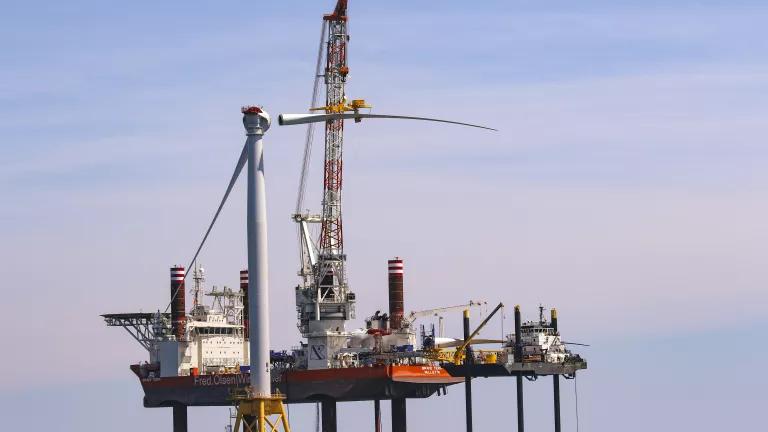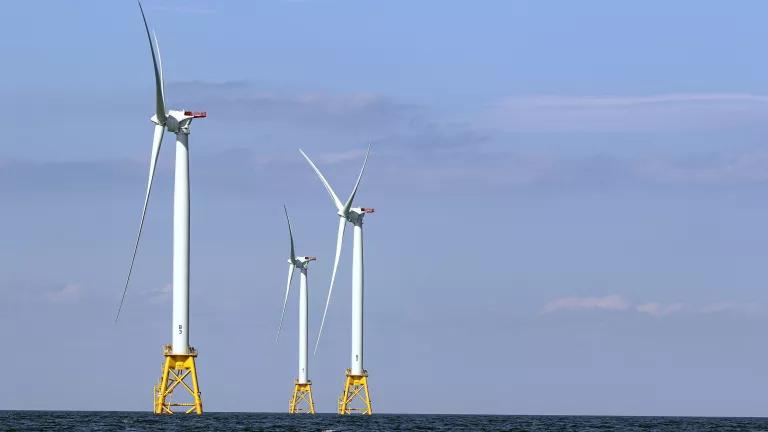CPUC Sends Strongest Signal Yet to Advance Offshore Wind
The California Public Utilities Commission just unanimously voted to approve a decision that establishes a strong central procurement pathway for offshore wind.

An under-construction offshore wind project takes shape on the East Coast. A recent CPUC decision means that California is one step closer to building similar projects off its coast.
BOEM/RODEO
The California Public Utilities Commission (CPUC) just took another significant step toward making offshore wind a reality off the California coast. At the Commission’s business meeting today, commissioners voted unanimously to adopt a Proposed Decision that, among other things, sets a need determination of 7.6 GW of offshore wind by 2035. This need determination – which is the amount of wind the Department of Water Resources (DWR) is eligible to procure under a centralized procurement process – sends a strong signal that offshore wind will play a key role in California’s electricity system going forward.
Centralized procurement of offshore wind in California
As we wrote earlier this summer, offshore wind is an important resource that is needed to meet California’s 2045 target to power its grid entirely on carbon-free energy. The state’s heavy reliance on solar means that offshore wind, which provides power during winter months and evening hours when solar is not producing electricity, will be critical for California to meet its clean energy goals.
Making offshore wind a reality in California requires significant coordination and collaboration between many state agencies, regulators, buyers, and sellers over many years. To build offshore wind cost effectively requires large-scale development of the wind turbines themselves, as well as transmission, ports, and other infrastructure. The size of the contracts needed to bring this initial amount of offshore wind online is greater than any one utility or load-serving entity’s (LSE) individual needs, which makes it a good candidate for a centralized procurement model, in which one entity negotiates contract with several developers on behalf of many utilities. AB 1373 (2023), which NRDC and other stakeholders supported, authorizes DWR to procure clean long lead time resources such as offshore wind on behalf of utilities and other LSEs.
A single buyer that can negotiate contracts on behalf of other LSEs can reduce risk to the developer, increase contracting efficiency, and lead to lower overall pricing.
CPUC Decision sets offshore wind on a path toward market transformation
A need determination of 7.6 GW is significant enough to provide certainty for transmission, port, and other infrastructure investments to move forward, and is in line with what NRDC supported in our opening and reply comments on the initial CPUC ruling.
The need determination sends a strong signal to the market, but the PD stops short of authorizing DWR to procure offshore wind at any price. The CPUC takes initial steps to put in place conditions to achieve cost reductions: it schedules three phases of procurement over 2027-2030 to allow learnings and cost reductions to be incorporated into bids later in the process. Additionally, the CPUC intentionally chose an amount of wind energy resource below the full lease area capacity in order to encourage competition and leave room for further cost reductions through learning and increased deployment.
Although the first bit of offshore wind may be expensive, its costs will come down over time as we get better at building them at scale and innovate. We’ve learned this lesson before. The first tranche of solar and wind was expensive, but California’s RPS policy helped create the market conditions that led to innovation and steep declines in costs to the extent that solar is the cheapest electric resource today. As CPUC and DWR establish procurement guidelines, and offshore wind scales, we can expect offshore wind cost declines as well.
A 7.6 GW offshore wind need determination is a crucial step toward establishing a strong offshore wind market that ultimately reaches California’s 25 GW by 2045 offshore wind planning goal, and California’s net zero emission power sector goal. Now, we need to develop a process to build offshore wind that is low-emission, reliable, and as cost-effective as possible.



